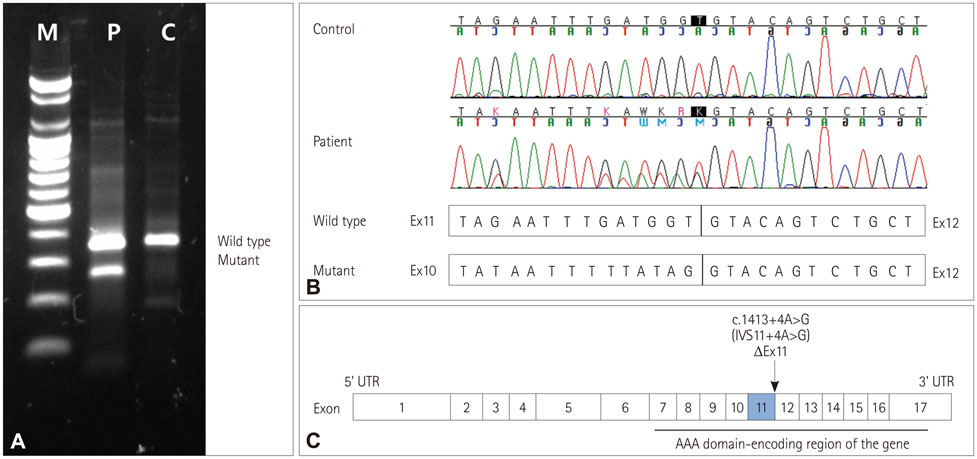J Clin Neurol.
2019 Jan;15(1):120-121. 10.3988/jcn.2019.15.1.120.
Novel Pathogenic Variant of SPAST (c.1413+4A>G) in a Patient with Hereditary Spastic Paraplegia
- Affiliations
-
- 1Department of Neurology, Gil Medical Center, Gachon University College of Medicine, Incheon, Korea. neurohm@gilhospital.com
- 2Department of Laboratory Medicine, Gil Medical Center, Gachon University College of Medicine, Incheon, Korea.
- KMID: 2451156
- DOI: http://doi.org/10.3988/jcn.2019.15.1.120
Abstract
- No abstract available.
MeSH Terms
Figure
Cited by 1 articles
-
Pure or Complex Hereditary Spastic Paraplegia Type 4?
Josef Finsterer
J Clin Neurol. 2019;15(2):265-266. doi: 10.3988/jcn.2019.15.2.265.
Reference
-
1. Richards S, Aziz N, Bale S, Bick D, Das S, Gastier-Foster J, et al. Standards and guidelines for the interpretation of sequence variants: a joint consensus recommendation of the American College of Medical Genetics and Genomics and the Association for Molecular Pathology. Genet Med. 2015; 17:405–424.
Article2. Lo Giudice T, Lombardi F, Santorelli FM, Kawarai T, Orlacchio A. Hereditary spastic paraplegia: clinical-genetic characteristics and evolving molecular mechanisms. Exp Neurol. 2014; 261:518–539.
Article3. Solowska JM, Baas PW. Hereditary spastic paraplegia SPG4: what is known and not known about the disease. Brain. 2015; 138:2471–2484.
Article4. Kumar KR, Blair NF, Sue CM. An update on the hereditary spastic paraplegias: new genes and new disease models. Mov Disord Clin Pract. 2015; 2:213–223.
Article5. Fink JK. Advances in the hereditary spastic paraplegias. Exp Neurol. 2003; 184 Suppl 1:S106–S110.
Article6. McDermott CJ, Burness CE, Kirby J, Cox LE, Rao DG, Hewamadduma C, et al. Clinical features of hereditary spastic paraplegia due to spastin mutation. Neurology. 2006; 67:45–51.
Article7. Svenson IK, Kloos MT, Gaskell PC, Nance MA, Garbern JY, Hisanaga S, et al. Intragenic modifiers of hereditary spastic paraplegia due to spastin gene mutations. Neurogenetics. 2004; 5:157–164.
Article
- Full Text Links
- Actions
-
Cited
- CITED
-
- Close
- Share
- Similar articles
-
- Arg460Cys Mutation in SPAST Gene in Patients with Hereditary Spastic Paraplegia
- Hereditary Spastic Paraplegia
- Autosomal Dominant Hereditary Spastic Paraplegia Relavant with a Novel Thr369Pro Mutation in SPAST Gene
- Pure or Complex Hereditary Spastic Paraplegia Type 4?
- Hereditary Spastic Paraplegia with a Novel SPAST Mutation Misdiagnosed with Subacute Combined Degeneration


